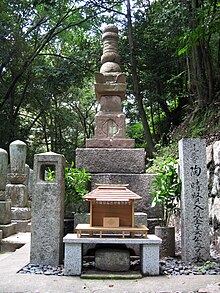In this Japanese name, the surname is Sue.
| Sue Harukata | |
|---|---|
| 陶 晴賢 | |
 | |
| Born | 1521 (1521) |
| Died | October 16, 1555(1555-10-16) (aged 33–34) Itsukushima, Japan |
| Nationality | Japanese |
| Other names | Sue Takafusa |
| Occupation | Shugodai of Suō Province |
| Known for | Tainei-ji incident Battle of Miyajima |
Sue Harukata (陶 晴賢, 1521 – October 16, 1555) was a samurai who served as a senior retainer of the Ōuchi clan in the Sengoku period in Japan. He was the second son of Sue Okifusa, a senior retainer of the Ōuchi clan. His childhood name was Goro, and he previously had the name Takafusa (隆房).
Biography
Harukata was born to the Sue clan, which was related to the Ōuchi clan, and served as shugodai of Suō Province. As a boy, he served Ōuchi Yoshitaka, a childhood friend. After genpuku, he was given the name Takafusa after Ōuchi Yoshitaka.
In 1539, after his father Okifusa died of illness, he became the head of the Sue clan. Being an able retainer, he became known as the Samurai General Without Peer in the Western Provinces (Saigoku-musō no Samuraidaishō).
From 1540 to 1542, he worked as the general, replacing Ōuchi Yoshitaka, in the war with the Amago clan. However, when Ōuchi's troops lost heavily in 1542, Yoshitaka's interest in war faded, and he began to incline to cultural activities. Because of this, the civil official Sagara Taketō became close to Yoshitaka, and Harukata's relationship with Yoshitaka declined.
In 1551, Harukata succeeded in the coup against Ōuchi Yoshitaka, killing Sagara Taketō and leading Yoshitaka to commit suicide. The next year Harukata secured the control of the Ōuchi clan by making the adopted son of Yoshitaka, Ōuchi Yoshinaga (who was Ōtomo Haruhide, the half-brother of Ōtomo Sōrin), the head of the clan. At this time he changed his name from Takafusa to Harukata, as his master changed from Yoshitaka to Haruhide. Subsequently, he conducted a large military expansion, but this led to discontent among the retainers of the Ōuchi clan.
In 1554 Yoshimi Masayori of Iwami Province, Yoshitaka's brother-in-law, and Mōri Motonari of Aki Province rebelled against Harukata.
In the Battle of Oshikibata, Sue Harukata's retainer Takagawa, was defeated by Mori Motonari.
In 1555 Harukata lost the Battle of Itsukushima to Mōri Motonari, and committed suicide after the battle. After the loss, his son Nagafusa was attacked by the Mōri clan and committed seppuku in Wakayama castle and the Ōuchi clan declined considerably. Two years later, Mōri Motonari annihilated the clan.

References
- ^ "日本大百科全書(ニッポニカ)「陶晴賢」の解説". kotobank. Retrieved October 21, 2021.
- Turnbull, Stephen (1998). The Samurai Sourcebook. Cassell & Co. p. 213. ISBN 1854095234.
- Sansom, George (1961). A History of Japan, 1334–1615. Stanford University Press. pp. 234–235. ISBN 0804705259.
- "日本の城がわかる事典「若山城」の解説" (in Japanese). kotobank. Retrieved November 13, 2021.
External links
- Profile of Hiroshima Prefecture
- 歴史街道 毛利家物語~武将たちが夢を追った戦国浪漫の道をたどろう~ Ministry of Land, Infrastructure and Transport (in Japanese)
- 益田氏・吉見氏ゆかりの城館群 Shimane Prefecture web site (in Japanese)
- Mori Clan Timeline at Samurai Archives
- 新井政義(編集者)『日本史事典』。東京:旺文社1987(p. 221)
- 竹内理三(編)『日本史小辞典』。東京:角川書店1985(p. 206)